Men in ‘skirts’, an insight into Scottish National Dress – Adam Warren
A historic piece of clothing which has stood the test of time – Tartan
With Nelson burns this coming weekend, now is the time when our Instagram feeds are blessed with all manners of people accessorising with colourful pieces of fabric, from family tartans to classics such as Royal Stewart and Hunting Stewart and others simply because the colours are nice. You may even spy some interesting characters (myself included) who will don a kilt in their family tartan.
According to Visit Scotland (The Scottish Tourism board) ‘tartan’ is a fabric made up of horizontal and vertical stripes (The interwoven stripes are known as a sett) in different colours, on a coloured background which originated in the Highlands. The first mention of tartan in Scotland was in 1538.
Originally, clanspeople used local plants, mosses and berries to dye the wool, hence differing regional tartans. The women of the village would combine local flora to make dyes and dye fabrics to distinguish between clans in battle and during peace. Lords, Clan leaders and other rulers would distribute their tartan for their warriors to wear (even if they were from a smaller clan) in order to distinguish combatants on the battlefield. This is why the various Scottish regiments (now amalgamated into the Royal Regiment of Scotland) wear one tartan. 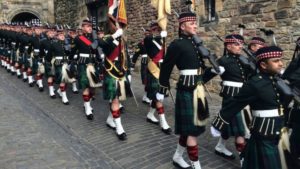
The Royal regiment of Scotland parading in Military Highland Dress.
The kilt, originally was an untailored, 5 metre-long piece of cloth. It was known as the féileadh mor in Gaelic (pronounced philamore), meaning the ‘big kilt’. It was worn both around the waist, similar to a modern kilt, but the remaining fabric was also draped over the shoulder and pinned. This upper portion could be adjusted according to the demands of weather, temperature or freedom of movement needed. It grew in popularity after being chosen by Highland regiments serving with the British Army.
A kilt is a piece of tartan, worn around the waist. However, a ‘proper’ kilt, known as Highland dress consists of:
A sporran – a small bag worn around the waist, over the kilt. Sporran is the Gaelic word for purse. I have also heard them dubbed ‘wee badger handbags’, owing to the animals skin on the front often coming from a badger.
A kilt pin – holds the two pieces together at the front. These are often highly decorative, made from silver and sometimes jewel encrusted.
Sgian dubh (pronounced skee-an doo) – a small dagger which sits in the sock. This has much historical significance too. When clans would meet for feasts and other such social occasions, as a sign of their alliances, the warriors would leave their weapons outside. However, medieval Scotland was not a place to be completely unarmed and hence, many carried small and lethally sharp blades in their sock to be used to defend themselves. Today, under UK law, a sgian dubh counts as an item of religious dress and thus may be carried when one is wearing highland dress. However, the blade must be less than 3 inches and Kilt makers will often have their shops searched by police Scotland to make sure this is still the case. Interestingly, the blades still have a groove, which would allow for the blade to be pulled out easily and prevent suction as well as a serrated edge for maximum damage.
The rest of the outfit would normally including a pair of shoes (Ghillie Brogues) with funny long laces, which will be wrapped a specific way around one’s hose (socks). On the side of the sock you will see tassels (called flashes) often in the same tartan as the kilt. Then depending on the occasion, a blazer and tie, jumper and shirt or most commonly black tie (usually the bonnie Prince Charlie Jacket – the Black blazer with military style buttons and ornamentation).
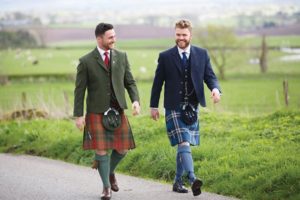
Highland dress with the Argyll jacket, the sporran hanging at the front, with the flashes visible off their hoses and kilt pins also visible. Note – The Sgian Dubh CANNOT be seen.
For a Scottish man, Highland dress is their black tie and many will not own a pair of black tie trousers. Kilts are predominantly seen at weddings, by the wedding party and guests, at Highland games, by athletes and spectators and most commonly at ceilidhs (especially Burns Night or Hogmanay – New Year’s Eve), by dancers, band and guest alike.
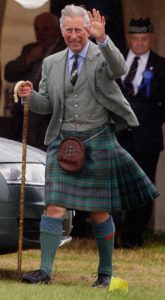
The Royal Family are advocates of the Kilt, with Prince Charles wearing one for most of his time in Scotland at Her Majesty’s Balmoral Estate.
One will also probably see many men wearing ‘trews’. Historically trews were part of the Highland cultural tradition, not Lowland. As such, when Lowland regiments became the first of the Scottish regiments to be formed in the mid-1660s to late 1680s, the Lowland soldiers wore standard British military uniform and had no desire to wear tartan items and march to the bagpipes, which they considered to be part of a foreign and savage culture. From these early beginnings up to 1881, the famous Lowland regiments wore standard British uniform. However, trews were increasingly worn as off-duty dress and even campaign dress from the late 18th century. Highland regiments stationed in hot or unhealthy surroundings often took to wearing simple white cotton trousers or tartan trews.
In 1822, following King George IV’s successful first visit to Scotland, he ordered the resumption of Highland dress and traditions for one de-kilted regiment. The regiment chosen was the most senior of the de-kilted regiments, the 72nd. (The same regiment who don their name to the famous marhc ‘The 72nd’s farewell to Gibraltar’). They adopted the Highland feather bonnet, but in lieu of kilts, they were ordered to wear trews for all duties. The tartan chosen was a new form of red or Royal Stewart called Prince Charles Edward Stuart, reflecting the new romantic fashion for all things Jacobite.
Due to the military use of trews by the Lowland regiments, the perception of trews as Lowland dress spilled over into civilian wear, so that for many years, trews began to be viewed as Lowland dress, rather than the Highland kilt.
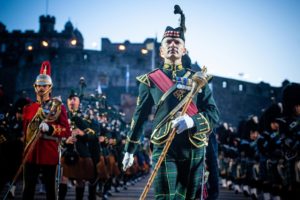
Senior Drum Major Michael Hay, The Royal Regiment of Scotland, in trews.
Especially in January, which see two of the most important events in Scotland (New year’s and Burns Night on the 31st Dec/ 1st and 25th Jan respectively), It is important to note, that for some tartans and the wearing of trews and especially kilts carry great significance, they are, after all, Scottish national dress. Although most are used to accusations of being a ‘skirt wearer’ and the timeless question regarding what is under a gentleman’s kilt (at any ceilidhs the answer is hopefully not the ‘traditional way’ as those dances can really make things entertaining) a degree of courtesy should be applied to those honouring their ancestry.
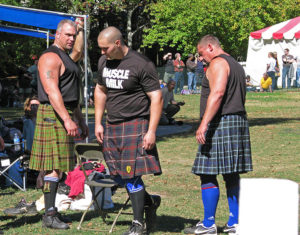
Would you tell these three that the they’re wearing skirts?
Be inquisitive, ask about people’s tartans, you are learning something about their family history (or favourite colour(s) depending on their ancestry).
Slange var!
I am a Contributor for the RHS Bubble
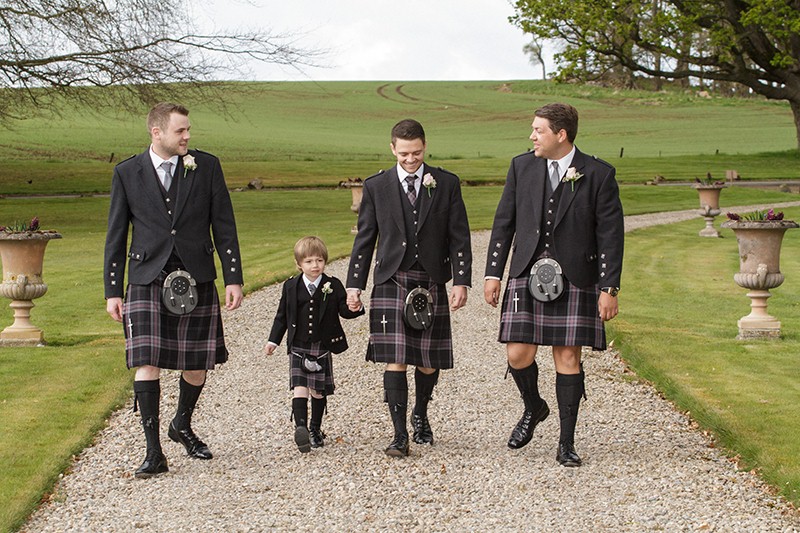


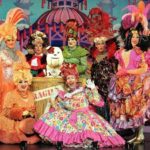











Post Comment
You must be logged in to post a comment.